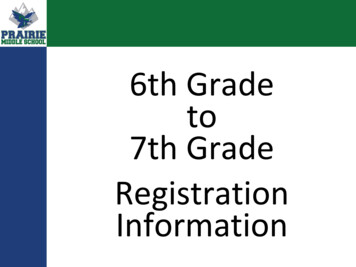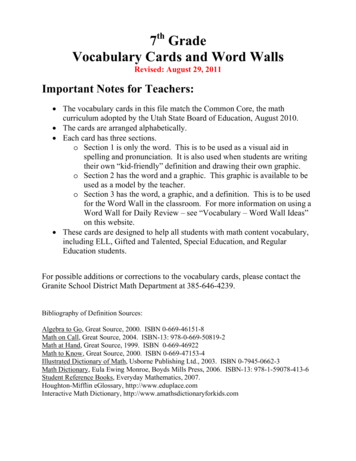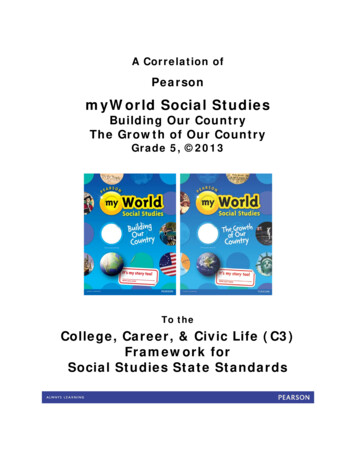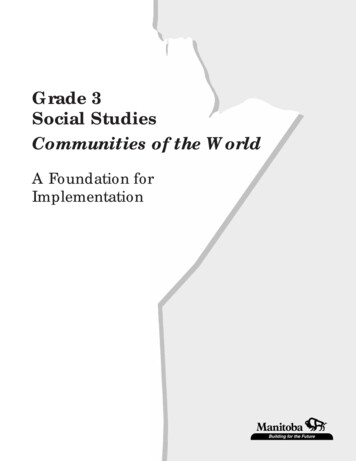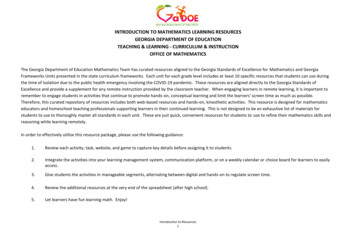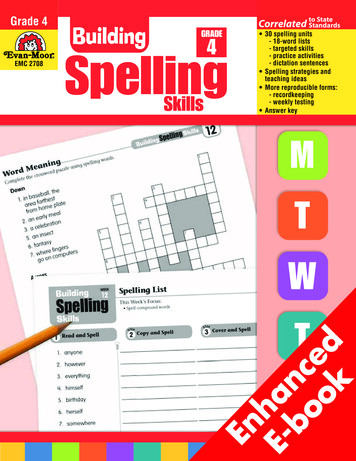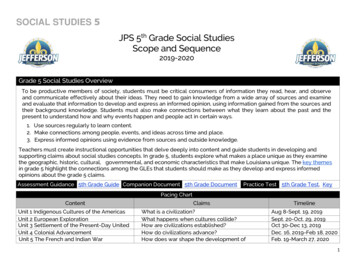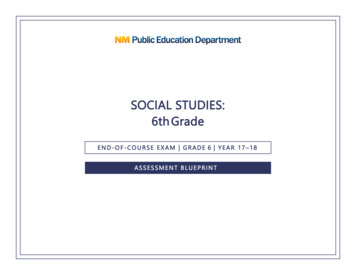
Transcription
SOCIAL STUDIES:6th GradeEND-OF-COURSE EXAM GRADE 6 YEAR 17–18ASSESSMENT BLUEPRINT
Purpose StatementGrade 6 Social StudiesThe Grade 6 Social Studies End-of-Course (EOC) Exam is intended to measure student proficiency of the New Mexico Social Studies Standards.This course-level exam is provided to all students who have completed a course in 6th Grade Social Studies.This exam can be given for the following STARS course codes: 2716 - 6th Grade Social Studies2704 - World History OverviewIntended as a final exam for the course, this is a summative exam covering a range of content, skills, and applications. Scores are reported tothe teacher, school, district, and state levels for the purposes of student grades, curriculum review, and NMTeach summative reports.“The EOCs are exams written by New Mexico Teachers for New Mexico Students.”During the 2016-17 school, year teachers were brought together in person and online to revise the blueprints. The NMPED extends ourgratitude to those who contributed to this improvement process. Although we were unable to implement every suggestion due to conflictingviewpoints at times, this blueprint reflects the best collaborative effort among dedicated peers.NMPED wants to especially recognize the following person(s) who led the revision for this blueprint: Ellen Virden, Content Lead & Lead Reviewer, Consultant, REC IXConnie Hudgeons, Albuquerque Public SchoolsNMPED Grade 6 Socail Studies EoC BlueprintProject Management byPage 2
Explanation of Blueprint & Test Specifications TableStandard/BenchmarkThe standards identified in this portionof the blueprint are aligned to the NewMexico State Social Studies al%20Studies/Social%20Studies%209-12.pdfNew Mexico Teachers identified thestandards to be measured on the EOCexam using the following criteria: 1) agreat deal of instructional time isspent on the standard as identified inthe curriculum and/or; 2) the standardis important to subsequent learning.It is important to note that thestandards in the blueprint are only asubset of standards to be measuredwith the understanding that teacherscover more standards during thecourse of instruction than what hasbeen selected to be measured.NMPED Grade 6 Socail Studies EoC BlueprintTest Item Specifications: This portion of the blueprint identifies the specific skills and knowledge students will have todemonstrate during the exam. Although the standard may be broader, the item specifications may place constraint onportions of the standards in order to provide more transparency as to what specifically willbe measured relative to the standard. Item specifications provide guidelines for the item writer so they know what topics tospecifically focus on when authoring items. Topics and terms in bold will be emphasized on the exam.Item Types:The item types for this EOC exam are limited to:MC Multiple Choice with or without stimulus (e.g., political cartoons, primary/secondary sources,diagrams, charts, timelines)Sample Question(s):Sample questions have been provided to assist teachers to correlate the questions with theperformance standards and the test item specification, when applicable. An * denotes the correct answer DOK Depth of Knowledge Some sample questions may be released items from prior EOC examsProject Management byPage 3
Blueprint and Specifications Table for Grade 6 Social ry.I.1-C.6.1eStrand: HistoryContent Standard I: Students areable to identify important peopleand events in order to analyzesignificant patterns, relationships,themes, ideas, beliefs, and turningpoints in New Mexico, UnitedStates, and world history in order tounderstand the complexity of thehuman experience.STANDARDS WITH TEST SPECIFICATIONSPerformance Standard with Test Specifications:1. describe and compare the characteristics of the ancient civilizations of Egypt, Mesopotamiaand China and explain the importance of their contributions to later civilizations, to include:a. significance of river valleys; early irrigation and its impact on agriculture;b. forms of government (e.g., the theocracies in Egypt, dynasties in China);c. effect on world economies and trade;d. key historical figures;e. religious traditions, cultural, and scientific contributions (e.g., writing systems, calendars,building of monuments such as the pyramids);Specifications: Compare and contrast ancient writing systems (i.e., hieroglyphics, cuneiform) Identify contributions of Hammurabi and Confucius Identify purposes of ancient structures (i.e., pyramids, ziggurat) Add Great Wall to e.g. list under (e)Item Type:MC with or without stimulusPractice Question: History.I.1-C.6.1eRead the passage and answer the question.Benchmark 1-C. World: compareand contrast major historical eras,events and figures from ancientcivilizations to the age ofexploration:Ziggurats in MesopotamiaZiggurats were massive structures built mostly in ancient Mesopotamia. Ziggurats were terracedstep pyramids with multiple stories or levels. The Mesopotamian ziggurats were not places forpublic worship or ceremonies.Mesopotamians believed that these pyramid temples connected heaven and earth. They wereNMPED Grade 6 Socail Studies EoC BlueprintProject Management byPage 4
thought to be homes for the gods. Only priests were allowed on the ziggurat. It was theirresponsibility to care for the gods and attend to their needs.One practical purpose of the ziggurats was to be a high place where the priests could escape fromthe annual river flooding. The ziggurat was often the central architectural feature around which acity was built.According to the passage, why did Mesopotamians build large, pyramid-like tory.I.1-C.6.2dStrand: HistoryContent Standard I: Students areable to identify important peopleand events in order to analyzesignificant patterns, relationships,themes, ideas, beliefs, and turningpoints in New Mexico, UnitedStates, and world history in order tounderstand the complexity of thehuman experience.NMPED Grade 6 Socail Studies EoC BlueprintA. as a place to bury the deadB. to bring heaven and earth closer together *C. as a place to hold public ceremoniesD. to serve as the palace for the rulerDOK 1This item was released from the NMPED EOC 2016-17 operational form.Standard with Test Specifications:2. describe and analyze the geographic, political, economic, religious and social structures of earlycivilizations of India, to include:a. location and description of the river systems and other topographical features that supportedthe rise of this civilization;c. structure and function of the caste system;d. important aesthetic and intellectual traditions (e.g., Sanskrit literature, medicine, metallurgy,mathematics including Hindu-Arabic numerals and the number zero);Specifications: NoneItem Type:MC with or without stimulusPractice Question: History.I.1-C.6.2cWhat was the name of the system developed in ancient India that strictly divided classes ofpeople?Project Management byPage 5
Benchmark 1-C. World: compareand contrast major historical eras,events and figures from ancientcivilizations to the age ofexploration:History.I.1-C.6.4Strand: HistoryContent Standard I: Students areable to identify important peopleand events in order to analyzesignificant patterns, relationships,themes, ideas, beliefs, and turningpoints in New Mexico, UnitedStates, and world history in order tounderstand the complexity of thehuman experience.Benchmark 1-C. World: compareand contrast major historical eras,events and figures from ancientcivilizations to the age History.I.1-C.6.6dNMPED Grade 6 Socail Studies EoC BlueprintA. dharmaB. citadelC. caste *D. hierarchyDOK 1This item was released from the NMPED 2016-17 operational form.Standard with Test Specifications:4. Describe major religions of the world to include Hinduism, Buddhism, Judaism, Christianity andIslam (e.g., founding leaders, traditions, customs, beliefs)Specifications: Compare and contrast major world religions Identify characters of major world religionsItem Type:MC with or without stimulusPractice Question:What do both Hindus and Buddhists believe?A. that Jesus Christ is their saviorB. the law of karma and reincarnation *C. the Four Noble TruthsD. the idea of baptismDOK 2This item was released from the NMPED EOC 2016-17 operational form.Standard with Test Specifications:6. compare and contrast the political and economic events and the social and geographiccharacteristics of medieval European life and their enduring impacts on later civilizations, toProject Management byPage 6
History.I.1-C.6.6eStrand: HistoryContent Standard I: Students areable to identify important peopleand events in order to analyzesignificant patterns, relationships,themes, ideas, beliefs, and turningpoints in New Mexico, UnitedStates, and world history in order tounderstand the complexity of thehuman experience.include:b. reasons for the fall of the Roman Empirec. new forms of government, feudalism and the beginning of limited government with the MagnaCarta;d. role of the roman catholic church and monasteries;e. causes, course and effects of the Crusades; impact of the black plague; contributions and rolesof key figures (e.g., Charlemagne, Joan of Arc, Marco Polo).Specifications: Identify hierarchy of feudal systemItem Type:MC with or without stimulusPractice Question: History.I.1-C.6.6eHow did the Black Plague affect Medieval Europe?Benchmark 1-C. World: compareand contrast major historical eras,events and figures from ancientcivilizations to the age ofexploration:History.I.1-D.6.1Strand: HistoryContent Standard I: Students areable to identify important peopleand events in order to analyzeNMPED Grade 6 Socail Studies EoC BlueprintA. It weakened the feudal system. *B. It ended the Crusades.C. It improved the health care system.D. It increased the general population.DOK 1This item was released from the NMPED 2016-17 operational form.Standard with Test Specifications:1. organize information by sequencing, categorizing, identifying cause-and-effect relationships,comparing and contrasting, finding the main idea, summarizing, making generalizations andpredictions, drawing inferences and conclusions;Specifications: Question will focus on interpretation of the main idea of a textProject Management byPage 7
significant patterns, relationships,themes, ideas, beliefs, and turningpoints in New Mexico, UnitedStates, and world history in order tounderstand the complexity of thehuman experienceItem Type:MC multiple choice with stimulusPractice Question:5-8 Benchmark 1-D.Skills: research historical events andpeople from a variety ofperspectives:If any one ensnare another, putting a ban upon him, but he cannot prove it, then he that ensnaredhim shall be put to death.The passages below are from the Code of Hammurabi which dates back to Babylonia around 1754BC:If any one bring an accusation against a man, and the accused go to the river and leap into theriver, if he sink in the river his accuser shall take possession of his house. But if the river prove thatthe accused is not guilty, and he escape unhurt, then he who had brought the accusation shall beput to death, while he who leaped into the river shall take possession of the house that hadbelonged to his accuser.If any one bring an accusation of any crime before the elders, and does not prove what he hascharged, he shall, if it be a capital offense charged, be put to death.Source: avalon.law.yale.edu/ancient/hamframe.aspAfter reading the passages from the Code of Hammurabi , what interpretation can be made aboutlaw in Ancient Babylonia?A. The law was forgiving, making sure people often got second chances.B. The law allowed for the judge to decide the punishment of those who were guilty.C. The law was very precise, and if a person was found guilty, the punishment was stated.*D. The law often favored the person who was accused of the crime.DOK 1NMPED Grade 6 Socail Studies EoC BlueprintProject Management byPage 8
Civics.III.3-A.6.1Civics.III.3-A.6.2Strand: Civics and GovernmentContent Standard III: Studentsunderstand the ideals, rights, andresponsibilities of citizenship andunderstand the content and historyof the founding documents of theUnited States with particularemphasis on the United States andNew Mexico constitutions and howgovernments function at local, state,tribal, and national levels.Benchmark 3-A: demonstrateunderstanding of the structure,functions and powers ofgovernment (local, state, tribal andnational):Standards with Test Specifications:1. describe the concept of democracy as developed by the Greeks and compare the evolution ofdemocracies throughout the world; and2. describe the concept of republic as developed by the Romans and compare to other republicangovernments.Specifications: Identify influences of Greek government that are still in existence today Know the roles of Roman society/hierarchyItem Type:MC with or without stimulusPractice Question: Civics.III.3-A.6.1Given the early civilizations below, which country’s government system was an example of directdemocracy?Strand: GeographyA. ChinaB. MesopotamiaC. Athens *D. IndiaDOK 1Standards with Test Specifications:1. Identify the location of places using latitude and longitude.2. Draw complex maps from memory and interpret them to answer questions about the locationof physical featuresContent Standard II: Studentsunderstand how physical, natural,and cultural processes influencewhere people live, the ways in whichSpecifications: Interpret map data Know cardinal directions when traveling from one location to another Questions on longitude and latitude on the exam will use the following PED Grade 6 Socail Studies EoC BlueprintProject Management byPage 9
people live, and how societiesinteract with one another and theirenvironments.Benchmark 2-A: Analyze andevaluate the characteristics andpurposes of geographic tools,knowledge, skills and perspectivesand apply them to explain the past,present and future in terms ofpatterns, events and issues:projection map as shown in the sample questionItem Type:MC with or without a stimulusPractice Question:What continent is located at 0 , 60 W?A. AsiaB. AfricaC. North AmericaD. South America *DOK 1This item was released from the NMPED EOC 2016-17 operational form.Economics.IV.4-C.6.1NMPED Grade 6 Socail Studies EoC BlueprintStandard with Test Specifications:1. compare and contrast the trade patterns of early civilizations;Project Management byPage 10
Strand: EconomicsContent Standard I : Studentsunderstand basic economicprinciples and use economicreasoning skills to analyze theimpact of economic systems(including the market economy)on individuals, families,businesses, communities, andgovernments.Specifications: Questions will be framed in historical contextItem Type:MC with or without a stimulusPractice Question:5-8 Benchmark 4-C: Describe thepatterns of trade and exchange inearly societies and civilizationsand explore the extent of theircontinuation in today’s erranean-trade-18638.jpg?cb 1376594473Which statement is supported by the map?A. Roman influence and goods were felt only in Europe and Africa.B. Roman influence and trade was felt throughout Europe, Africa and the Middle East.*NMPED Grade 6 Socail Studies EoC BlueprintProject Management byPage 11
C. Roman influence and trade was very narrow in scope for the time period.D. Roman trade was done only through water routes, thus limiting its impact.DOK 26th Chart Social Studies EoC Reporting Category AlignmentReporting CategoriesStandard1Ancient Civilizations: Egypt,Mesopotamia, China and Major World ReligionsMedieval EuropeSkills in HistoryMaps and Identification of PlacesConcepts of Democracies and Republics,and Human Characteristics of RegionsGrand TotalNMPED Grade 6 Socail Studies EoC BlueprintDOK(Count by roject Management byPage 12
Grade 6 Social Studies The Grade 6 Social Studies End-of-Course (EOC) Exam is intended to measure student proficiency of the New Mexico Social Studies Standards. This course-level exam is provided to all students who have completed a course in 6th Grade Social Studies. This exam can be given for the following STARS course codes: 2716 - 6th .
